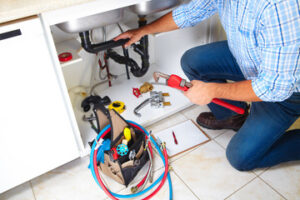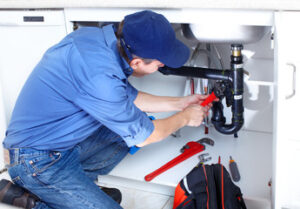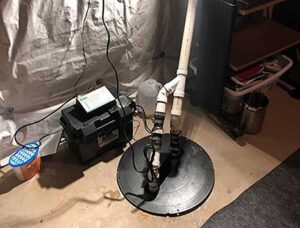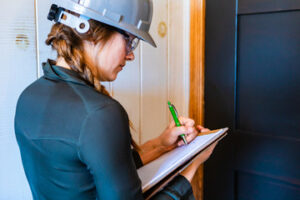Sandy Springs Plumbers are the system that conveys water to and from different building parts. Its job is to deliver potable drinking water, remove wastewater, and protect against contamination and sewage spills. Plumbers also abide by codes and regulations to ensure safety and functionality. With them, we would have clean water and effective waste disposal.

The water heater is an appliance that keeps hot water on hand for showering, dishwashing, laundry, and other household tasks. Most modern water heaters are tank-type appliances that use electricity, natural gas, propane, or heating oil as their energy source. Water enters the tank through a dip tube and is heated by the heating mechanism until it reaches your desired temperature. The hot water exits the tank through the hot water service line, which is usually located at the top of the tank. The water heater also has a drain valve and a shut-off valve.
The drain valve is situated at the bottom of the tank and resembles a large ball valve. It drains the tank periodically to remove sediment (e.g., rust, scale, bits of corroded anode) that gathers at the bottom of the tank over time. A professional technician should always conduct this procedure, called a “flush” or drain and flush, to extend the life of your water heater.
Depending on the water heater’s manufacturer, you can find a model with built-in anti-scale devices or other features that reduce mineral buildup and speed up heating. Some tanks are also lined with glass to minimize corrosion and increase the lifespan of the heating element. The warranty on the heater is also an important factor; look for models with longer warranties, which typically include a larger heating element and thicker insulation to reduce energy consumption.
Typical residential water heaters have capacities between 75 and 400 L (20 to 100 US gal). Electric models are the most popular for homes without a natural gas connection. Consider a hybrid or solar water heater if you want to save energy. These models are more expensive than standard tanks, but they offer significant savings in energy costs and can offset installation costs with government rebates and other incentives. Consider looking for a certified water heater that meets minimum efficiency standards set by the federal government. The EPA estimates that these models are 82% more efficient than traditional tanks, which can significantly cut your energy bill.
Pipes are the foundation of your home plumbing system. They connect your fixtures to the water supply line and transport wastewater to the sewer or septic tank. Depending on your type of pipes, they may be made of different materials. Each material has its advantages and disadvantages. Understanding the differences between pipe and tubing can help you decide which is right for your household.
A pipe is a hollow cylinder with a circular cross-section, used mainly to convey substances that can flow — liquids and gases (fluids), slurries, powders, or masses of small solids. Pipes are primarily constructed of metal, though some are fabricated from concrete or plastic and are manufactured in various ways. Extensive codes govern the fabrication process and the materials used for piping. Pipes are typically standardized for dimensions and by industry; residential construction, for example, falls under different codes than power or chemical plants.
The metal pipe is usually sold in standard diameters, each defined by an outside dimension and wall thickness. Pipes are welded together using methods ranging from manual brazing to robotic welding. For higher-pressure applications, joints are joined with gasket flanges. Flanges come in various sizes and designs, including threaded, integral, lapped, and welded, with raised or tongue-and-groove facings.
Most residential plumbing systems use PVC, PEX, or ABS pipes. These pipes are durable, easy to work with, and affordable. They’re also color-coded for hot and cold water, making them easy for plumbers to identify. PVC and PEX pipes are also resilient to freezing temperatures. The most common types of plastic pipe are polyvinyl chloride (PVC) and acrylonitrile butadiene styrene (ABS).
Pipes from other materials, such as steel or reinforced concrete, are typically used for larger-diameter or high-pressure applications. Steel pipe can be welded, cast, or formed to meet the required specifications. It’s also available in various pre-fabricated assemblies, such as tees and elbows, to make the job easier for installation craft laborers. For these higher-pressure pipes, joints are joined with gasketed forged, threaded, or lapped flanges.
Fixtures are appliances that connect to a plumbing system and perform a specific water supply or waste disposal function. They include sinks, bathtubs, showers, toilets, and faucets. They can come in various shapes, sizes, and styles to suit your home or business. Plumbing fixtures are an important part of any home or building; keeping them in good condition is essential to ensure proper water flow.
When choosing plumbing fixtures, consider how they will be used and your lifestyle. You will also want to consider price point, style, and material factors. A wide range of choices are available, so it is important to research before making any decisions. Consider consulting with a design professional to help you find the perfect fixtures for your space.
Most plumbing fixtures have a shut-off valve, also known as a stop valve, installed on the water line that leads to them. This allows you to turn off the water to a particular fixture in an emergency or when making repairs. You should also install a backflow preventer on the main line to avoid water backflow.
There are many different plumbing fixtures, each with unique features and functions. The most common are sinks, toilets, and showers. Each of these has its purpose and benefits, but all work together to provide clean, fresh water for use in the home or business.
It is important to choose CSA-approved plumbing fixtures to meet the minimum standards for safety and performance. It would help if you also ensured that the fixtures you chose are durable materials that withstand wear and tear.
The number of plumbing fixtures in a space often determines the pipe size required to accommodate the demand. Several codes and standards have been developed that correlate the number of fixture units to the appropriate pipe size. This helps plumbers and engineers determine the proper piping for any given situation.
Drains allow excess water and waste to flow from specific fixtures like sinks and toilets into the sewage or septic system. The drain pipes are designed with traps to prevent sewer gasses from entering the house and vents to help the pipes maintain pressure. Depending on the type of piping, these systems can last for decades or even eons, although it is best to keep up with routine maintenance to prevent leaks and other problems.
The opening of a drain is connected to the sink basin, which collects wastewater and other substances. The curved pipe, or the P-trap, holds water to create positive pressure and blocks sewer odors from entering your home. If the P-trap becomes dry, it is simple to fill with water to restore this vital feature. By law, all drains must have a working P-trap.
While the pipes that bring fresh water into your home are largely copper, some drain lines may be steel or plastic. The drain pipes are usually insulated to prevent heat loss. The insulated pipe is also less likely to burst, a common problem with old metal pipes.
Unlike supply plumbing, drain pipes do not pump water into the system; they rely on gravity to do their work. Drain lines are often sloped to ensure water flows downward, away from the fixture. This helps to avoid stagnant water and other debris buildup, which can cause health risks.
The drainage system removes wastewater from a household, funneling it to the sewage or septic system to avoid flooding the house and creating hazardous materials like soap scum, mold, and other toxins. The drainage system can be passive or active; stagnant drains rely on gravity, body movement, and pressure differentials to move fluids, while functional drains use negative pressure to pull fluid from wounds and cavities. Nursing staff should follow written instructions for managing drains and monitor the site regularly for drainage, signs of infection, and other issues. A drain inserted for abscess or disease may be bloody at first but should lighten over time.


